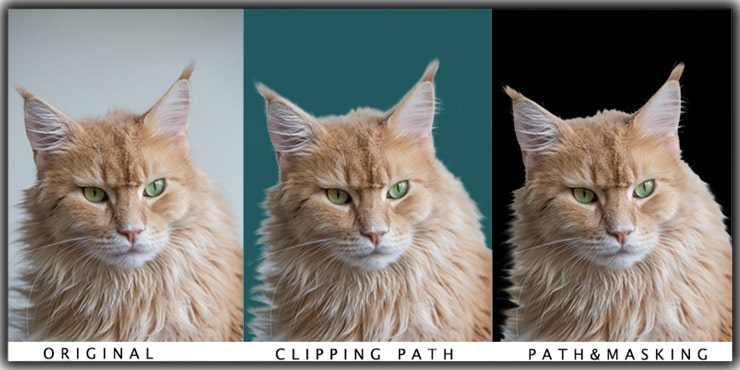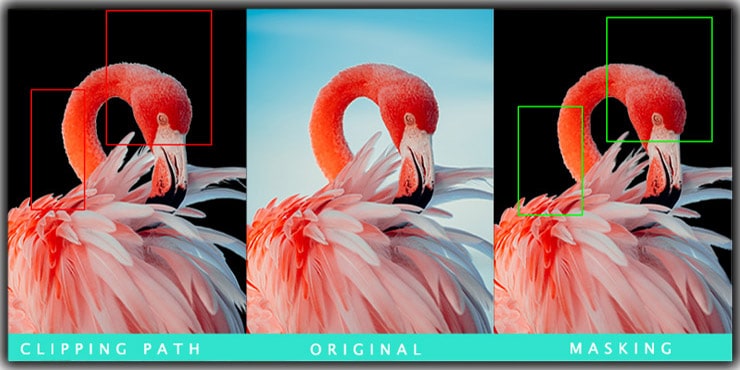Know the key differences between Clipping Path Vs Masking two background separation techniques and use them perfectly.
Clipping Path and masking are helpful methods for isolating subjects from image backgrounds. The purpose of the two techniques is the same, removing the background. However, they are not the same by the process of application.
What are those differences? Today we will discuss the difference between clipping path Vs masking. So stick to the article from first to last and the proper difference. Let’s dive in.
What is a Clipping Path?
Clipping Path is an image editing technique done using Photoshop’s Pen tool. The purpose is to eliminate the background of photos and extract the subjects. A clipping path is primarily used if the subject or object in the picture has smooth, sharp edges. The path stays straight and cuts out the object.
Later, these extracted contents are used in other backgrounds for various personal or commercial purposes. It may seem easy to draw a path, but it is not. If the path is drawn imperfectly, it will result in unnatural and unrealistic photos appearing.
Hence, photo editing experts zoom into pictures requiring their needs. For example, sometimes, they need to zoom into 200% to draw accurate paths around the edges. This process is essential because the commercial world needs clipping path service most to create product-promoting images.

What is Image Masking?
The motive of image masking is the same as the clipping path, which means removing the backgrounds. But there are a few differences we will discuss eventually. With the various tools in Photoshop, you can do image masking. The Magic Eraser tool, Background Eraser Tool, and color Separation Technique are used.
Now, when is the right time to use image masking? It’s when your images contain subjects with many small details and fine lines. For the e-commerce world, it’s sweaters with fuzz, stuffed animals with fur, or human models with different hair types.
In image masking techniques, you sometimes require using one, and others need more. The different grounds require various methods.

For example, pictures with complicated edges can sometimes contain multiple background colors, including shadows. You probably have to use a blend of image masking procedures in such cases.
Clipping Path Vs Image Masking – What are the Key Differences?
Earlier, we have said clip-path and masking are almost the same things. There are, however, a few differences. These varieties may seem nothing special, but they make the two methods of cutting out photos vary from one another.
We will find out below those critical differences and why they should be carefully checked before deciding whether your image needs a path or masking.
Edge of the subject
The edges in images are a huge factor that tells you which one of the two techniques you must choose. Clipping Path means drawing straight paths over sharp edges. Any object that doesn’t have complex edges is cut out front photos through a clipping path method. The path is for pictures with thick and hard edges.
On the other hand, image masking is required when the photographs carry objects with tiny details and various lines. These are complicated enough to detect and draw paths over. Image masking is for pictures with slim and soft edges.

Destructive and Non-destructive
The clipping path does the best job of cutting images containing simple-shaped subjects. It can also work on complicated sharp edges. However, the method is destructive.
We are saying this is destructive because it’s impossible to get back to the earlier form after you are drawn a path with the Pen tool. Although you can edit the path points yet, it will look unpleasant.
On the contrary, it’s pretty simple to handle even subjects with super complex edges through image masking.
It allows you to return to any part you want when you make a mistake. Moreover, this process lets you hide and reveal parts in Images. In short, we can say that image masking is non-destructive.
Compatibility
The essential thing we need to keep in mind while separating subjects of a photo is compatibility. You must pick the correct approach when editing pictures. Choose the technique wisely depending on what kind of subject your image has.

There is confusion when we don’t understand which method will be effective in path or masking for several images. Because you will encounter some photos with both soft and hard edges, both the image separation approaches are consistent in such a situation.
You will have to do a path over the hard portion and masking on the soft part. In this case, it’s better to do the path before masking. It will ensure a zero percent error.
Image Type
Focus well on your image type if you want the best results. An image can have varieties. For example, the subject in the photograph may have soft edges, sharp edges, solid or multicolor background.
An image with hard edges always requires a path. Other factors like image opacity, background color, hardness, or softness never matter. Hard-edged subjects are cut out perfectly with this method.

Harshness and Smoothness
Whether the image subject has harshness if the edges are hard, it needs a path. The same is with the smoothness. Conversely, soft-edged subjects require masking, no matter the picture’s level of harshness or smoothness.
Time Consumption
Since clipping paths work on simple edges photos, it takes less time than masking. However, I don’t think it is done within an hour or a half. Sometimes it takes over hours to complete to make an accurate cutout.

But things are a little different when it comes to image-making. Since this method is used on pictures with tiny lines, it generally takes hours. So whether you’re a professional photo editor or a practitioner, you can’t finish image masking within an hour or two. Then again, when you need to work with both approaches, you might spend less or more time depending on the type of image.
FAQs
Both the techniques are for background removal. However, some pictures suit a clipping path and others with image masking. Any image consisting of hard edges will bring the best output with a path, while any photos consisting of soft edges will get the best output with image masking.
The path and masking have one prime similarity, that is, detaching a subject from the background of an image.
Image masking means separating a subject with soft edges, small details, and fine lines. But path detaches the subject with hard edges, less complicated subjects.
So, it’s a bad idea to use a path for further masking. Instead, you can try the multiple path approaches, which will only make the output look uglier.
Closing Remarks
Know the differences between the path and masking. This knowledge will help you understand which technique to use or which service to choose. We hope you have a clear concept of clipping paths and image masking.
We covered all the details in the difference between clipping path Vs masking article. To collect further info, read our relatable articles.
